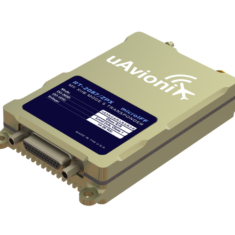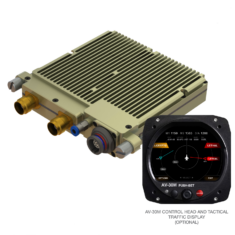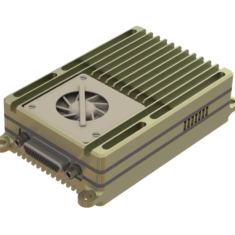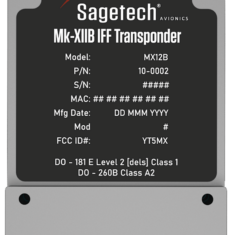For UAV and UAS programs that support NATO military forces, the latest Mode 5 IFF (Identification Friend or Foe) prerequisites require vehicles to update by July 1, 2020. Many large manned aircraft platforms have complied using traditional commercial avionics-sized transponders. Drones, UAVs (unmanned aerial vehicles) and UAS (unmanned aerial systems) are set to comply using micro Mode 5 IFF transponders.
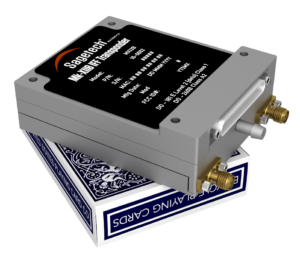
Certified DoD AIMS 17-1000 XIIB micro IFF transponders from Sagetech Avionics
Mode 5 Identification System
Certified micro Mode 5 transponders are required for use in NATO military equipment as well as other allied countries.
Mode 5 is an air-combat identification system which positively distinguishes friendly from enemy aircraft, reducing fratricide and unauthorized incursions. The technology employs spread-spectrum radio transmissions that are difficult for adversaries to intercept or jam, and also features secure data encryption.
IFF Military Certification Requirements for UAS
Military mission UAVs and UAS must include IFF Mode 5 transponder technology, and this technology must be certified by the US DoD AIMS Program Office or similar NATO country government office before the transponder can be used in mission flight.
IFF was in effect for decades as IFF Mode 4. Today this legacy technology is replaced by Mode 5 with updated specifications that dictate stronger encryption, different response prioritization in the transmitter, and GPS information about target aircraft locations.
Older IFF Specification
IFF Mode 4 and Mode 5
DoD AIMS 03-1000
Mark XIIA
Replaced by Current IFF Specification
IFF Mode 5
DoD AIMS 17-1000
Mark XIIB
The DoD AIMS 03-1000 Mark XIIA specification is still valid, but requires updating to the newer levels of specification.
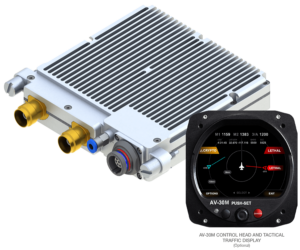
ZPX-C IFF Mode 5 Transponder by uAvionix
Mode 5 Transponder Specifications
Within the Mode 5 specifications, there are different levels of response to interrogations by other aircraft:
Level 1 – Identifies the aircraft with the transponder as friendly, provides a proper encrypted response.
Level 2 – Adds GPS position information to the Level 1 reply.
Lethal interrogation – If the target aircraft’s transponder is in standby mode, it will “wake up” and respond to this type of interrogation.
| Capability | Mode 5 Level 1 | Mode 5 Level 2 |
| Reply and/or squitter frequency | 1090 MHz | 1090 MHz |
| Interrogation frequency | 1030 MHz | 1030 MHz |
| Interrogation/Reply | [tick] | [tick] |
| Periodic squitter | [tick] | |
| Pressure altitude information | [tick] | [tick] |
| Position information | [tick] | |
| Identification information | [tick] | [tick] |
| Encrypted | [tick] | [tick] |
Source: Mitre Presentation, IEEE.
Transponders that carry the necessary IFF Mode 5 AIMS 17-1000, Mark XIIB, Levels 1 and 2 certification are authorized to incorporate the necessary encryption keys.
Functionality Required for Mode 5 IFF Transponders
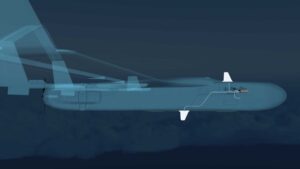
UAV IFF Mode 5 micro transponder requires antenna diversity, shown here with fin antennas on the top and bottom of the airframe. Source: Sagetech Avionics
Within IFF military specifications, several functionalities are required for certification and use on military mission programs.
- Civil Modes A, C, and S functionality
- ADS-B Out
- Mode 5 response prioritization
- Antenna diversity for space-based and ground-based visibility
- Incorporation of internal crypto, or compatibility with an external crypto computer such as the KIV-77 or KIV-78
- Satisfy the robust environmental standards of MIL-STD-461 and MIL-STD-810.
Additional capabilities that may be available in micro IFF Mode 5 transponders include:
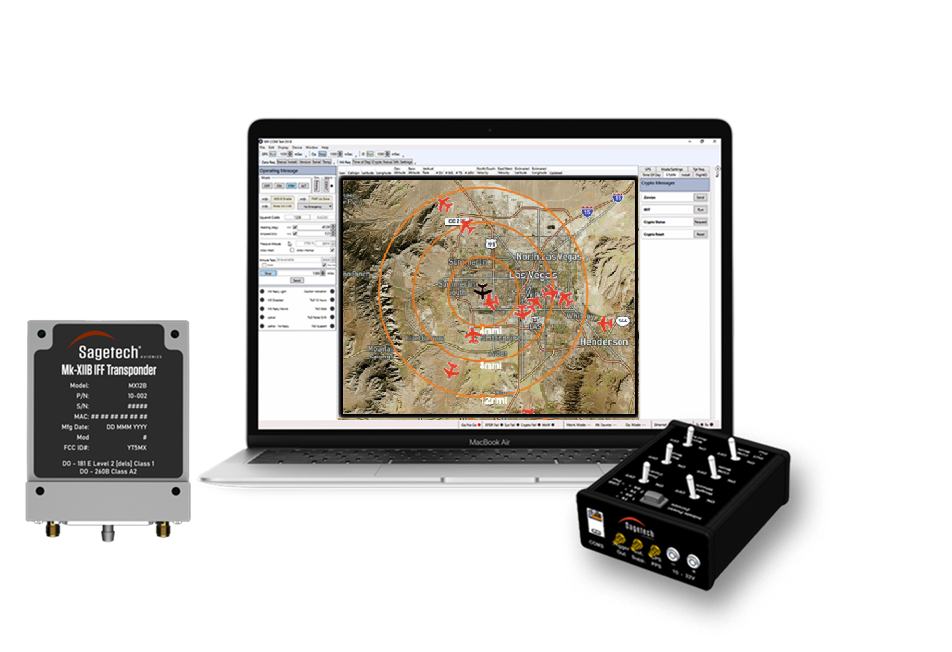
MX12B System with ADS-B In visualization
- Integrated ADS-B In. While Mode 5 IFF will be used in a military combat or training mission, if a military UAV will fly in the national airspace system (NAS) at all for a non-military mission, it should include ADS-B In capability for situational awareness and communication with ATC and TCAS.
- Upgrade capability. New specifications are emerging for Mode 5 Level 2B In and Out. Micro IFF Mode 5 transponders should carry an upgrade path to include this future requirement.
- Small size and weight. While some UAV programs have incorporated commercial aircraft-sized equipment to comply with Mode 5, today UAV programs have the option of using certified micro-transponders that are up to 9x smaller and 6x lighter than traditional “small sized” transponder solutions.
- External crypto (appliqué). Using an external crypto simplifies the logistics of maintaining and operating controlled hardware.
Thanks to Sagetech Avionics for their input with this technology overview >>






